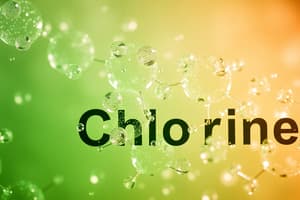Podcast
Questions and Answers
Who proposed the four elements theory?
Who proposed the four elements theory?
- Dalton
- Democritus
- Lavoisier
- Aristotle (correct)
What did Lavoisier discover about oxygen?
What did Lavoisier discover about oxygen?
- It is a metal
- It is a solid at room temperature
- It was a myth
- It is essential for combustion (correct)
Which branch studies substances not considered organic?
Which branch studies substances not considered organic?
- Analytical Chemistry
- Inorganic Chemistry (correct)
- Organic Chemistry
- Physical Chemistry
What is the study of nanochemistry concerned with?
What is the study of nanochemistry concerned with?
What defines a solid?
What defines a solid?
Which state of matter is compressible?
Which state of matter is compressible?
Which of the following is a characteristic of liquids?
Which of the following is a characteristic of liquids?
Which of the following is an extensive property?
Which of the following is an extensive property?
Which statement describes a chemical change?
Which statement describes a chemical change?
What is the boiling point?
What is the boiling point?
What process describes a solid turning into a gas?
What process describes a solid turning into a gas?
What does the atomic number represent?
What does the atomic number represent?
Who is credited with developing the periodic table?
Who is credited with developing the periodic table?
What type of reaction occurs when an acid reacts with a base?
What type of reaction occurs when an acid reacts with a base?
What is an ionic bond?
What is an ionic bond?
Which element has the highest atomic number?
Which element has the highest atomic number?
Study Notes
Historical Theories and Discoveries
- Four elements theory proposed by Aristotle: earth, water, air, fire.
- Lavoisier discovered oxygen is essential for combustion.
- Alchemy primarily associated with the transmutation of metals into gold.
- Phlogiston Theory developed by a scientist (not Lavoisier).
- Dalton's atomic theory states that atoms are indivisible.
Branches of Chemistry
- Inorganic Chemistry studies substances not considered organic.
- Physical Chemistry focuses on chemical changes and the properties of matter.
- Nanochemistry concerns the properties and manipulation of nanomaterials.
- Food Chemistry analyzes the chemistry of food products.
- Forensic Chemistry examines crime scene evidence and related substances.
States and Properties of Matter
- Solids have a definite shape and volume.
- Gases are compressible states of matter.
- Liquids possess a definite volume but take the shape of their container.
- A homogeneous mixture has a uniform composition throughout.
- An extensive property, such as mass, changes with the amount of substance.
Changes in Matter
- Physical change involves a change in appearance without altering composition.
- Boiling point: temperature at which a liquid transforms into a gas.
- Sublimation describes the process when a solid turns directly into a gas.
- Chemical changes occur when new substances are formed, such as rust on iron.
- Condensation refers to the transformation of gas into a liquid.
Atomic Structure and the Periodic Table
- Atomic number indicates the number of protons in an atom.
- Electron configuration determines the chemical properties of an element.
- Dmitri Mendeleev credited with developing the periodic table based on periodic law.
- Periodic law states that elemental properties repeat periodically when arranged by atomic number.
- Oganesson has the highest atomic number among elements.
Chemical Bonds and Reactions
- Ionic bond characterized by the transfer of electrons between atoms.
- Neutralization reaction occurs when an acid reacts with a base.
- Catalysts speed up chemical reactions by lowering activation energy.
- Combustion reaction products typically include water and carbon dioxide.
- Decomposition reactions involve the breakdown of a compound into simpler substances.
Studying That Suits You
Use AI to generate personalized quizzes and flashcards to suit your learning preferences.
Description
Test your knowledge on historical theories and discoveries in chemistry, including Aristotle's four elements and Lavoisier's findings. Explore various branches of chemistry such as inorganic, physical, and food chemistry, alongside the states and properties of matter. Challenge yourself and enhance your understanding of this fundamental science.




